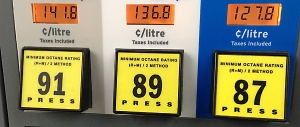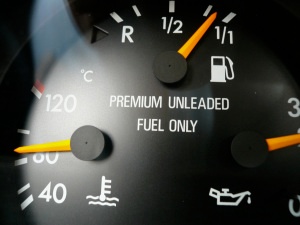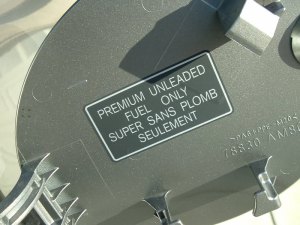 Ask any car enthusiast what they believe is the proper fuel for their car and chances are, you’ll receive a variety of answers. From a resounding, “Yes! Using premium will save you fuel and improve performace!” to, “No, premium is a waste”. As a matter of fact, I’ve often questioned my own fueling habits, especially when the difference between a tank of premium and regular fuel can mean having a hot meal on the plate, or a cold one from the fridge.
Ask any car enthusiast what they believe is the proper fuel for their car and chances are, you’ll receive a variety of answers. From a resounding, “Yes! Using premium will save you fuel and improve performace!” to, “No, premium is a waste”. As a matter of fact, I’ve often questioned my own fueling habits, especially when the difference between a tank of premium and regular fuel can mean having a hot meal on the plate, or a cold one from the fridge.
For readers who like a quick and easy answer, it is simple. Read your owner’s manual. For those like myself who like to dissect manufacturer specifications and recommendations, read on.
To start off, we need to understand why there are different grades of fuel in the first place. In general, there are three fuels available at the pump: 87, 89, and 91, or Regular, Plus, and Premium, respectively. These numbers refer to the octane number. Octane numbers are only used with gasoline, and not Diesel. This post talks exclusively about the use of gasoline.
The octane number represents the ability of a fuel to withstand knock. Why is this important? Knock is detrimental to your engine and too much of it will most certainly lead to expensive engine repairs like a blown head gasket or in some cases, total engine replacement.
To explain knock, you have to have a basic understanding of the operation of an engine. During the compression stroke of an engine, the piston compresses the air/fuel mixture into a much smaller volume. The amount of compression is known as the compression ratio such as 10:1 or 12:1. A 10:1 compression ratio means the engine compresses the air/fuel mixture into a final volume 1/10th its initial volume just before ignition. The initial volume is measured as the volume in the cylinder when the piston is at its lowest position, or Bottom Dead Center (BDC). The final volume is of course, the volume when the cylinder is in its top-most position, or Top Dead Center (TDC).
You can never damage your engine by running a higher-octane fuel in your car than recommended. But damage is possible if you fill up with a lower-octane.
 If a fuel has too low of an octane number for a specific application, *high temperature, compression, or a combination of both will ignite the air/fuel mixture at sub-optimal timing, either before the piston reaches TDC and before the spark ignites or after the spark ignites but in an uncontrolled manner. Technically speaking, knock only occurs AFTER the spark and pre-ignition is BEFORE spark ignition. The pressure in the cylinder will spike from the improper ignition of the fuel, causing more pressure than the engine was designed to withstand. Instead of the pressure pushing your piston down, it will try to escape through other weaker parts of your engine. The higher-octane fuel simply reduces the chances of knock occurring. You can never damage your engine by running a higher-octane fuel in your car than recommended.
If a fuel has too low of an octane number for a specific application, *high temperature, compression, or a combination of both will ignite the air/fuel mixture at sub-optimal timing, either before the piston reaches TDC and before the spark ignites or after the spark ignites but in an uncontrolled manner. Technically speaking, knock only occurs AFTER the spark and pre-ignition is BEFORE spark ignition. The pressure in the cylinder will spike from the improper ignition of the fuel, causing more pressure than the engine was designed to withstand. Instead of the pressure pushing your piston down, it will try to escape through other weaker parts of your engine. The higher-octane fuel simply reduces the chances of knock occurring. You can never damage your engine by running a higher-octane fuel in your car than recommended.
A manufacturer will specify premium fuel if the conditions inside the cylinder require it. Advanced spark timing, high compression ratios, or the use of turbochargers are all reasons, among others, to specify premium over regular fuel. Racecars will use high performance 100+ octane fuel because of the harsh environment of consistently high engine RPMs, high engine temperatures, high compression, and aggressive spark timing, all of which are perfect circumstances for knock to occur. If a car has regular fuel as its recommended fuel type, you will generally see little to no benefit of running premium fuel.
In North America, premium fuel is sold and marketed as just that, a premium product, and thus, you’re paying for a better product, right? Well, I believe premium fuel should really be sold as a different specification, just like choosing one weight of oil viscosity over another. After all, 10W30 is the same price as 5W30. Why premium and regular vary so much in price beats my engineering knowledge.
Going back to our original question, does my car need premium fuel? Now that you know the reasoning of a manufacturer specifying higher versus lower octane fuel, it would be unwise to go against the manufacturer recommendation.
But we know the conversation doesn’t end there.
How about those of us who want to save some money and put regular fuel into our cars, which specify premium? Are we going to have a catastrophic engine failure? Not so fast, Mr. Apocalypse.
Ever since the dawn of an engine computer, engines have had knock sensors to detect knock occurrences before they became a major issue. These sensors pick up inconsistencies in combustion which would not otherwise be there if the engine was operating fine. Once the engine computer determines if there is a problem detected by the knock sensor, there are generally two ways the computer will attempt to sort itself out:
- Delay the spark timing
- Inject more fuel into the air/fuel mixture to make it rich
The whole idea is to reduce the speed of ignition. Knock is essentially a circumstance where the fuel ignites too quickly. Both delaying the spark timing and using a richer air/fuel mixture will slow down the ignition of fuel. In case you’re wondering what ‘slow’ means in this context, we’re talking milliseconds, much faster than the blink of an eye.
Using a combination of spark timing and adjustment of the air/fuel ratio, advanced engine computers allow many people to put regular fuel into a car which recommends premium, without the driver noticing much difference. But indeed, there is a difference.
A delayed spark will reduce the power of your engine while richer air/fuel mixtures will use up more fuel, negating some of the savings at the pump from filling up with regular fuel. The effects of using a lower octane fuel will be most felt while under high engine loads and high temperatures. For those lightly cruising around town or on the highway, it is unlikely the difference will be very noticeable.

I will finish this off with a personal experience. My ’91 Volvo 940 is a GLE model with the B234F high compression engine. Premium fuel is specified. For one 4-hour trip, I used premium and another, regular fuel. Using a light foot and never going full throttle, I did not see a major difference, either from the amount of fuel used, or the operation of the car. On the flipside, my friend had been driving his 2003 Honda Insight on regular fuel for a long while, making similar trips as myself. On a whim, he switched to premium and never looked back. Premium fuel smoothed out the engine and improved his fuel economy a slight amount. Different cars, same fuel used, different results.
The moral of the story is, different engines will display different results. I’ve always played it safe and filled with premium where specified, apart from the odd tank of regular gas when I was experimenting. When driving cars that did not specify premium, I found no need to run anything but regular. As I’ve already stated above as a rule of thumb, refer to your owner’s manual when in doubt.
If you have a personal experience, let us know in the comments below.
*edited August 2nd, 2014. 12:25 PM EST.
 About the Author: Tim Wong
About the Author: Tim Wong
Tim is a Canadian from Windsor, which means he has plans to use his Volvo as an emergency space heater. He is a mechanical engineer by day and backyard mechanic by night. His mantra in life is to never break another bolt.











